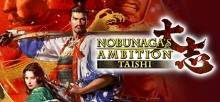Nobunaga's Ambition: Taishi (PlayStation 4) Review
By Drew Hurley  15.06.2018
15.06.2018

The Nobunaga's Ambition series is an unbelievably long-running one, with the first coming all the way back in 1983 on PC. Since then, the series has appeared not only on PC but also upon countless home consoles over the years, from SEGA Mega Drive, to Saturn, to Dreamcast; on SNES and PSP, and each version of Sony's PlayStation. This latest is the fifteenth installment, and the second on PlayStation 4 after last year's Sphere of Influence, and was also the first to be redesigned for the mobile market. How did it turn out? Cubed3 finds out.
The opening intro completely belies the truth to this game. A great looking FMV shows the titular Nobunaga living out a great life in feudal Japan. He hawks, drinks sake, looks out over his lands, and even jumps from horseback to swim in a river. What kind of dynamic, exciting game could this be?! Not at all what newcomers in the audience may expect… The series is made up of huge, turn-based strategy titles where the player can step into the shoes of various famous characters from Sengoku Japan and play out scenarios based around famous events, such as the Kawagoe Night Raid, the Battle of Itsukushima, and the Battle of Takagi River.
To "win" in these scenarios is simple: take over the map. This is done by slowly expanding ever outwards via diplomacy against rival clans or by crushing them under heel, turning them into (hopefully) loyal vassals. Each turn is a turn of the moon, with a month playing out each time, at the start of which the opportunity to give orders appears. Gameplay pauses while deciding what strategies to pursue and there are a handful of standard activities that become the norm from the very first month. Mostly this is setting up relationships and growing in strength. Expanding in commerce into trade zones, undertaking diplomacy with rival clans to be able to move into their territory and partake of the opportunities for new trade. Then there's building up of infrastructure and provisions, plotting out the agriculture tasks, hiring ronin, organising the officers of the clan, and taking part in council meetings.

During council meetings, the chosen officers gather in council and selecting, which to take advice from opens up "Policies" on a huge Sphere Grid style map that shapes the play-style, increasing various stats for the clan and giving numerous benefits. It's something to pay close attention to in the starting few turns… or to pay no attention to at all by setting up delegations for each and every one of these choices. That's right, these can all be automated. Each of the many actions that can be chosen each turn fall under set categories: Commerce, Agriculture, Trade, Development, Recruitment, Postings, and Council Actions. Each can be Delegated, so the game makes decisions itself, effectively making the game as fun as watching someone else play Risk. Once all the strategies are chosen, the turn switches to the active turn when the chosen actions of all Daimyo across Japan play out. Forces move, trade agreements are struck, alliances made and broken.
This delegation system is the perfect analogy for the whole title. For those new to the series, it seems full of complex and interesting systems, but it quickly becomes apparent that despite the numerous options, settings, and choices, that it's all a thin veneer. It's all surprisingly simple after playing for a short while, something that will be quickly evident for veterans of the series and those experienced with this type of release. For them, this is a gross simplification. Even the occasional battles that take place aren't very enjoyable, each being horribly slow, and particularly ugly - even compared to previous games in the series - and, frankly, dull.

Cubed3 Rating
Bad
Considering this is the fifteenth in the franchise, Koei Tecmo took a big risk by trying to attract an all new audience and it failed spectacularly. Understanding where Nobunaga's Ambition: Taishi came from can help to explain it. It was released not just for PC originally, but for tablet also, hence the big changes and simplified features. In this bold move, Koei Tecmo managed to not only drive away its loyal fan-base but also fail to bring in any new fans to the series. Ultimately, the final product is just dull, too simple to appeal to the hardcore, and too dense to appeal to the casual. It's hard to see who could enjoy this outside of hardcore J-History buffs and, even then, a textbook would be more entertaining.

![]() 3/10
3/10
![]() 0
(0 Votes)
0
(0 Votes)
 Out now
Out now  Out now
Out now  Out now
Out now  Out now
Out now Comments
Comments are currently disabled

 Sign In
Sign In Game Details
Game Details Subscribe to this topic
Subscribe to this topic Features
Features





 Top
Top

